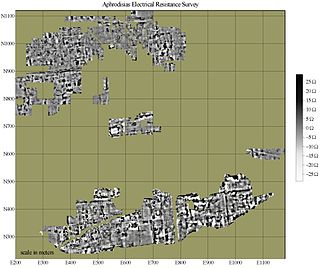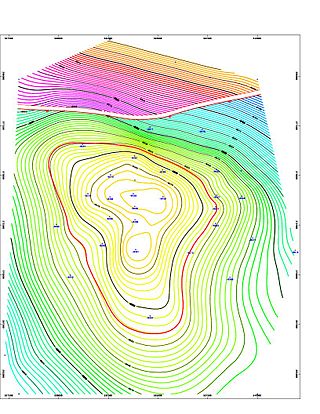Related Research Articles

Geophysics is a subject of natural science concerned with the physical processes and physical properties of the Earth and its surrounding space environment, and the use of quantitative methods for their analysis. Geophysicists, who usually study geophysics, physics, or one of the Earth sciences at the graduate level, complete investigations across a wide range of scientific disciplines. The term geophysics classically refers to solid earth applications: Earth's shape; its gravitational, magnetic fields, and electromagnetic fields ; its internal structure and composition; its dynamics and their surface expression in plate tectonics, the generation of magmas, volcanism and rock formation. However, modern geophysics organizations and pure scientists use a broader definition that includes the water cycle including snow and ice; fluid dynamics of the oceans and the atmosphere; electricity and magnetism in the ionosphere and magnetosphere and solar-terrestrial physics; and analogous problems associated with the Moon and other planets.

In archaeology, geophysical survey is ground-based physical sensing techniques used for archaeological imaging or mapping. Remote sensing and marine surveys are also used in archaeology, but are generally considered separate disciplines. Other terms, such as "geophysical prospection" and "archaeological geophysics" are generally synonymous.

Finite-difference time-domain (FDTD) or Yee's method is a numerical analysis technique used for modeling computational electrodynamics. Since it is a time-domain method, FDTD solutions can cover a wide frequency range with a single simulation run, and treat nonlinear material properties in a natural way.
Exploration geophysics is an applied branch of geophysics and economic geology, which uses physical methods at the surface of the Earth, such as seismic, gravitational, magnetic, electrical and electromagnetic, to measure the physical properties of the subsurface, along with the anomalies in those properties. It is most often used to detect or infer the presence and position of economically useful geological deposits, such as ore minerals; fossil fuels and other hydrocarbons; geothermal reservoirs; and groundwater reservoirs. It can also be used to detect the presence of unexploded ordnance.

Magnetotellurics (MT) is an electromagnetic geophysical method for inferring the earth's subsurface electrical conductivity from measurements of natural geomagnetic and geoelectric field variation at the Earth's surface.

Computational electromagnetics (CEM), computational electrodynamics or electromagnetic modeling is the process of modeling the interaction of electromagnetic fields with physical objects and the environment using computers.
Geophysical survey is the systematic collection of geophysical data for spatial studies. Detection and analysis of the geophysical signals forms the core of Geophysical signal processing. The magnetic and gravitational fields emanating from the Earth's interior hold essential information concerning seismic activities and the internal structure. Hence, detection and analysis of the electric and Magnetic fields is very crucial. As the Electromagnetic and gravitational waves are multi-dimensional signals, all the 1-D transformation techniques can be extended for the analysis of these signals as well. Hence this article also discusses multi-dimensional signal processing techniques.
GeoModeller is a methodology and associated software tool for 3D geologic modelling developed by Bureau de Recherches Géologiques et Minières and Intrepid Geophysics over the last 20 years. The software is written using Open CASCADE in C++ for the engine, Java for the GUI and data are stored in extensible mark-up language XML. GeoModeller has started to revolutionise the working practices, data standards and products of a geological survey as a whole. The software takes into account all structural geology data such as dip, dip directions, strike, hingelines and axialtrace to build the geometry of geological units.

Electronic circuit simulation uses mathematical models to replicate the behavior of an actual electronic device or circuit. Simulation software allows for the modeling of circuit operation and is an invaluable analysis tool. Due to its highly accurate modeling capability, many colleges and universities use this type of software for the teaching of electronics technician and electronics engineering programs. Electronics simulation software engages its users by integrating them into the learning experience. These kinds of interactions actively engage learners to analyze, synthesize, organize, and evaluate content and result in learners constructing their own knowledge.
The controlled source electromagnetic (CSEM) method, also called sea bed logging, is a mostly offshore geophysical technique, employing electromagnetic remote-sensing technology to map the electric resistivity distribution of the subsurface. The electrical resistivity helps to discriminate between different types of rocks. CSEM is mostly used to indicate the presence and extent of hydrocarbon below the seabed.
In geophysics, seismic inversion is the process of transforming seismic reflection data into a quantitative rock-property description of a reservoir. Seismic inversion may be pre- or post-stack, deterministic, random or geostatistical; it typically includes other reservoir measurements such as well logs and cores.
Biological data visualization is a branch of bioinformatics concerned with the application of computer graphics, scientific visualization, and information visualization to different areas of the life sciences. This includes visualization of sequences, genomes, alignments, phylogenies, macromolecular structures, systems biology, microscopy, and magnetic resonance imaging data. Software tools used for visualizing biological data range from simple, standalone programs to complex, integrated systems.

JMAG is a simulation software used to develop and design electric devices. JMAG was originally released in 1983 as a tool to support the design of devices such as motors, actuators, circuit components, and antennas.
A synthetic seismogram is the result of forward modelling the seismic response of an input earth model, which is defined in terms of 1D, 2D or 3D variations in physical properties. In hydrocarbon exploration this is used to provide a 'tie' between changes in rock properties in a borehole and seismic reflection data at the same location. It can also be used either to test possible interpretation models for 2D and 3D seismic data or to model the response of the predicted geology as an aid to planning a seismic reflection survey. In the processing of wide-angle reflection and refraction (WARR) data, synthetic seismograms are used to further constrain the results of seismic tomography. In earthquake seismology, synthetic seismograms are used either to match the predicted effects of a particular earthquake source fault model with observed seismometer records or to help constrain the Earth's velocity structure. Synthetic seismograms are generated using specialized geophysical software.

In the oil and gas industry, reservoir modeling involves the construction of a computer model of a petroleum reservoir, for the purposes of improving estimation of reserves and making decisions regarding the development of the field, predicting future production, placing additional wells and evaluating alternative reservoir management scenarios.
The FORAN system is an integrated CAD/CAM/CAE system developed by SENER for the design and production of practically any naval ship and offshore unit. It is a multidisciplinary and integrated system that can be used in all the ship design and production phases and disciplines. The System collects all the information in a single database. FORAN is mainly focused on the design of:
Electromagnetic Geoservices ASA (EMGS) is a Norwegian geophysical services company using proprietary marine electromagnetic technology to support oil and gas companies in their search for offshore hydrocarbons. The administrative and research headquarters are located in Trondheim.

GPlates is open-source application software offering a novel combination of interactive plate-tectonic reconstructions, geographic information system (GIS) functionality and raster data visualisation.
Predictive engineering analytics (PEA) is a development approach for the manufacturing industry that helps with the design of complex products. It concerns the introduction of new software tools, the integration between those, and a refinement of simulation and testing processes to improve collaboration between analysis teams that handle different applications. This is combined with intelligent reporting and data analytics. The objective is to let simulation drive the design, to predict product behavior rather than to react on issues which may arise, and to install a process that lets design continue after product delivery.
Michael Semenovich Zhdanov is a geophysicist, academic and author. He is a Distinguished Professor in the Department of Geology and Geophysics at the University of Utah, Director of the Consortium for Electromagnetic Modeling and Inversion (CEMI), as well as the Founder, chairman and CEO of TechnoImaging.
References
- ↑ "EMIGMA Complete" (PDF). 2 January 2017. Archived from the original (PDF) on September 27, 2020.
- ↑ "EMIGMA Basic". 2 January 2017.
- 1 2 Groom, R.W.; Hyde, C.H.; Lajoie, J. (1996). "A case study of the application of the EMIGMA modelling package in interpretation of UTEM data over the Cominco Cerattepe deposit in Turkey" (PDF). 66th SEG Conference. Denver, Colorado.
- ↑ "EMIGMA EM for Oil and Gas". 2 January 2017.
- ↑ Dadfar, H.; Heck, R. J.; Parkin, G. W.; et al. (October 2011), "Evaluation of a Geonics EM31-3RT probe to delineate hydrologic regimes in a tile-drained field.", Precision Agriculture, 12 (5): 623–638, doi:10.1007/s11119-010-9203-4, S2CID 19104152
- ↑ Zogala, B.; Dubiel, R.; et al. (July 2009), "Geoelectrical investigation of oil contaminated soils in former underground fuel base: Borne Sulinowo, NW Poland", Environmental Geology, 58 (1): 1–9, Bibcode:2009EnGeo..58....1Z, doi:10.1007/s00254-008-1458-y, S2CID 128620414
- ↑ Bevan, Bruce W.; Smekalova, Tatiana N. (2013), "Magnetic Exploration of Archaeological Sites", Good Practice in Archaeological Diagnostics, Springer International Publishing, ISBN 978-3-319-01783-9
- 1 2 Cheng, Li Zhen (Jan 2006), "Geophysical case study of the Iso and New Insco deposits, Québec, Canada: Part II, modeling and interpretation" (PDF), Exploration and Mining Geology, 15 (1–2): 67
- 1 2 3 Groom, R.W.; Jia, R.; Alvarez, C. (2003), "Investigations into Inversion of Magnetic and Gradient Magnetic Data for Detection and Discrimination of Metallic Objects" (PDF), 2003 SAGEEP Annual Symposium, San Antonio, Texas
{{citation}}: CS1 maint: location missing publisher (link) - 1 2 "EMIGMA V7.0 Ready For Beta Testing" (PDF). 2 January 2017.
- ↑ "MITEC Project" (PDF). 2 January 2017.
- 1 2 "Release of Version 9.1". 2 January 2017.
- 1 2 3 4 5 6 7 8 "EMIGMA Full Manual" (PDF). 2 January 2017. pp. 3–18.
- ↑ Duckworth, K. (December 2005), "Comparison of Theoretical and Physical Model Studies of the Responses of Moving Source and Fixed Loop Electromagnetic Exploration Systems" (PDF), Pure and Applied Geophysics, 162 (12): 2519, Bibcode:2005PApGe.162.2505D, doi:10.1007/s00024-005-2782-8, S2CID 129523217
- ↑ Parker, Robert L. (1994), Geophysical Inverse Theory , Princeton University Press, ISBN 978-0-691-03634-2
- ↑ "3D Data Representation and Multiple Plates Now Available" (PDF). 2 January 2017.
- ↑ Jia, R.; Davis, L. J.; Groom, R. W. (November 2011), "1D-Time Domain Inversion Incorporating Various Data Strategies with a Trust-Region Method" (PDF), 10th China International Geo-Electromagnetic Workshop, Nanchang, China
{{citation}}: CS1 maint: location missing publisher (link) - ↑ "VH Plate Development" (PDF). 2 January 2017.
- ↑ "Sneak Preview into EMIGMA Version 5" (PDF). 2 January 2017.
- ↑ "Focus: Improved Induction" (PDF). 2 January 2017.
- ↑ "GeoTutor Key Features". 2 January 2017. Archived from the original on 4 April 2017. Retrieved 2 January 2017.
- ↑ "EMIGMA V7.8 - New Features". 2 January 2017.
- ↑ "EMIGMA V8.1 is now available". 2 January 2017.
- ↑ "New features in EMIGMA and QCTool". 2 January 2017.
- ↑ "EMIGMA developments". 2 January 2017.
- ↑ "EMIGMA V9.0 release" (PDF). 2 January 2017.
- ↑ "Extensions to 1D TDEM Inversion capabilities". 2 January 2017.